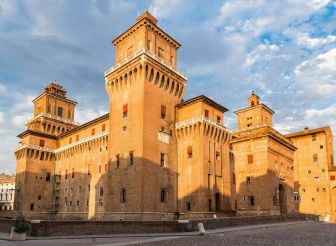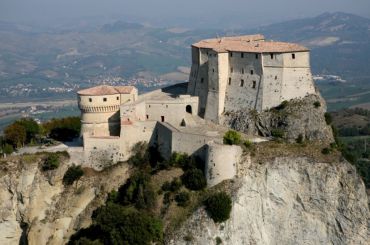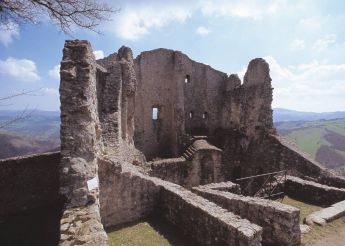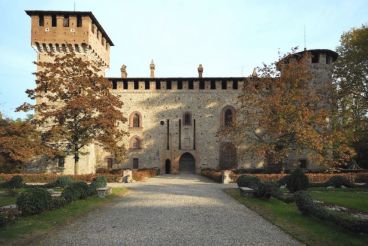Estense Castle, Ferrara

The Castello Estense is a monumental medieval fortress located in the heart of Ferrara. This building is really impressive because there is nothing bigger or more beautiful than it in the entire ancient city. Throughout many centuries, since its completion, the castle has played a key role in the lives of not only the rulers but the whole city. And over time it turned into a luxurious noble residence.
History of the castle
The decision to build the castle was taken by the ruler of Ferrara, the Marquis Niccolo II d'Este. This was preceded by a powerful rebellion of the townspeople on May 3, 1385, caused by high taxes. In order to protect himself from the riots in the future, the sovereign laid the first stone of the future castle near his palace on September 29, 1385. It was named after St. Michael, but later it was renamed as the Castello Estense, which refers to the owners of the structure. The castle connected the already existing tower of the city wall and the Marquis’ residence. Bartolino da Novara was put in charge as an architect. A few years later heavy walls, three more towers, and a lifting bridge were finished, the fortress itself was surrounded by a moat. In 1476 Ercole I d'Este started a major reconstruction of the castle. The architect Girolamo da Carpi was the one who designed the exterior we can see today.
Alfonso I d'Este was transforming the place into a rich residence since 1507. His son, Alfonso II, continued decorating the interior after his father. The son, however, died and didn’t leave any heir. The Pope did not hesitate to take advantage of that fact and soon took control of the property. The fortress became the residence for cardinals and legates.
After Ferrara united with Italy in 1860, the castle came into state ownership, and in 1874 it was purchased by the administration of the province of Ferrara for 70,000 lire. Thus, it served as the province center for many years. At the same time, the castle was constantly properly maintained, then a prolonged restoration was performed during 1910–1930. After the place suffered damage during the Second World War, it was slightly restored in 1946.
In 1999, the head of the province founded the project "Il Castello per la Città," aimed to fully renovate the castle. In 2002, the administration was moved to a new location, at the same time the exhibition "The Triumph of Bacchus" was opened, and then in 2004 an exhibition dedicated to the presence of the Este family in Ferrara was put on display. In 2006, the restoration was completed, the well-known designer Gae Aulenti worked on the creation of new spaces. After the earthquake in 2012, a new restoration was started which ended later in 2015.
Exterior and interior design of Estense Castle
The castle is square-shaped at its base and has four towers standing on each corner, strongly defining the appearance and recognizability of the whole structure. A moat with three bridges built over it is surrounding the place. They, on the other hand, lead to three entrances. Before the defensive moat, there are defensive structures made of brick. The harshness of the forms is especially evident on the first floor of the castle, but if you look up, you can see the elegance and decorations which are more characteristic to a palace. You might also notice balconies, instead of usual prongs, and the towers from the defensive structures turned into terraces. The castle has plenty of rooms; its interiors are quite impressive in its beauty. The most significant and characteristic ones among them are:
- Gothic halls. It consists only of four austerely designed bedrooms. These were the chambers of the princes of Ferrara and the d'Este marquises. Each one of them is decorated with a large number of paintings illustrating the city life in the 14th–16th centuries. There are also a number of portraits on the walls depicting the ruling family. In the main room, there is a castle model made of wood in the 14th century.
- Kitchens. They are part of the outbuilding in the eastern part of the castle that dates back to the 16th century. Simple rooms for cooking food are followed by beautiful banquet rooms.The Lion's Tower. This is the cornerstone of the entire castle. That’s where the whole construction began. And before that, the tower which was part of the city wall was so fortified that it looked more like a small fort.
- Jail. It is located under the Lion’s Tower. It was meant for high-ranking prisoners. The son of Marquis Niccolo III, Ugo d'Este, and brothers Alfonso I, Giulio and Ferrante d'Este. Writings carved out by the prisoners can be still found on the walls.
- Garden of Oranges. This is a beautiful garden, replicated from the drawings by Girolamo da Carpi. The castle loggia above the garden served as a winter greenhouse.
- Chapel. It was built in 1591. It is quite simple. However, its the ceiling is decorated with an elegant fresco with images of 4 animals, symbolizing four evangelists.Aurora Hall. The place is beautifully decorated with tapestries and mirrors dating back 15th century according to the documents. The main decoration of the room is a fresco on the ceiling. It depicts four parts of the day, revolving around the central image of time. It allegorically depicts the course of human life.The Hall of Games. It was a guest room or marquis’ reception room if you will. The hall is embellished with frescoes portraying various kinds of sports competitions that were popular during the Renaissance.
- Tower of Santa Caterina. It was the home of the young duke Alfonso I along with with the adjoining rooms. They were called "apartments of patience."
- Tower of San Paolo. Along with the Tower of Santa Caterina, it suffered from an earthquake in 1570. Therefore it was later reconstructed. Today its interior looks much more austere compared to the other halls; its design follows a bit different patterns.
- Landscapes Room. Its walls and ceiling look like a unique picturesque composition. Delightful landscapes can be seen on them, Poseidon is put in the center.
- Coats of Arms Room. These are the largest rooms of the castle and at the same time the most important. This was the place where gala receptions were held during the times of the dukes and cardinals; meetings of the provincial administration council were held here as well before the restoration was performed in 1999. The room is decorated with a lot of heraldic symbols, mostly coats of arms of castle’s former owners.
In addition to the main tour through the castle, temporary art exhibitions are set up here quite regularly. The structure has own cafeteria and a bookshop as well as rooms designed for seminars, conferences and other events. It also offers a rather unusual service – a boat excursion during which the group travels around the castle through the defensive moat.
How to get
The Castello Estense is located in the historic center of Ferrara, on Largo Castello, 1. The central city squares called Piazza Municipale, and Piazza Savonarola can be found nearby. A little further away there are the Jewish Museum and Palazzo Schifanoia. The nearest bus stop is Giovecca Teatini (buses 1,4, 6, 7, 8, 9, 10, 13, 21, 323, 390, 392, 396, 399).
Opening hours: from Monday to Friday from 09:30 to 17:30, from Saturday to Sunday from 09:30 to 18:00. The ticket office closes 45 minutes early. The place is closed on Mondays during October–December. Contact number: (+39) 0532 299233.
Admission: the ticket price depends on the month, various discounts are available. Children under 6 are free of charge. You will need to pay extra money to take part in a guided tour or to access the Lion’s Tower.






